
- Index
- Listed By
- Material
- Size
- Style
- Abstract (20)
- Abstract, Modernism (6)
- Americana (5)
- Art Deco (9)
- Art Nouveau (4)
- Art, Realism (4)
- Dutch (4)
- Dutch, Realism (5)
- Expressionism (23)
- Folk Art (9)
- Impressionism (150)
- Impressionist (5)
- Modernism (12)
- Portraiture (6)
- Realism (163)
- Still Life (22)
- Traditional (10)
- Traditional, Realism (4)
- Victorian (18)
- Vintage (58)
- Other (476)
- Subject
- Unit Of Sale
MARGO HOFF ANTIQUE MODERN IMPRESSIONIST OIL PAINTING OLD NEW YORK PARK SCENE 50s
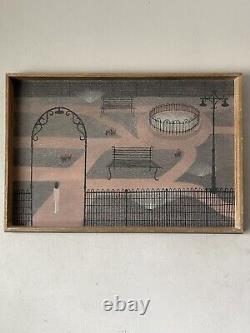


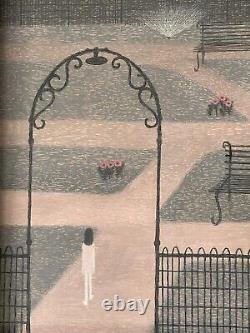
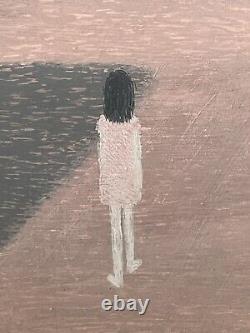

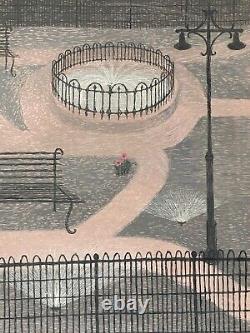
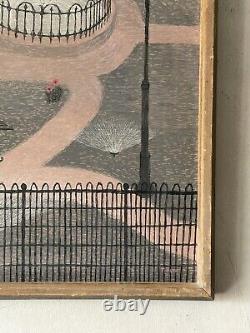
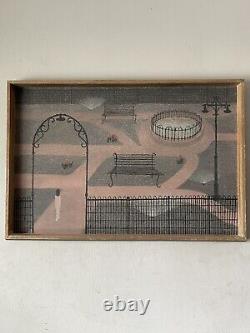
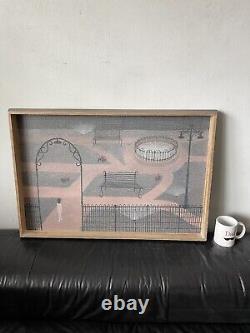
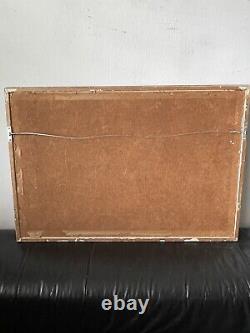
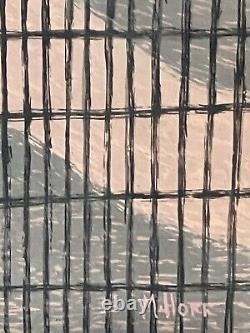



EXCEPTIONAL AND CHARMING ANTIQUE MODERN IMPRESSIONIST ACRYLIC PAINTING ON BOARD BY REVERED NEW YORK MODERNIST PAINTER MARGO HOFF. THIS WORK DEPICTS A ENCHANTING PICTURESQUE PARK SCENE IN NEW YORK. COMPRISED OF A YOUNG GIRL WALKING THROUGH AN ELEGANT PARK ADORNED WITH STYLIZED DECORATIVE IRONWORK AND WATERFALLS. THIS IS A DREAMY AND ROMANTIC MASTERPIECE. SIGNED BY M HOFF IN THE LOWER RIGHTHAND CORNER.
IT DATES AROUND THE 1960s. SCRATCHES AND WEAR TO THE ORIGINAL FRAME, AS SHOWN. DIMENSIONS: 22" H x 31" W. Margo Hoff (1912 - 2008) was active/lived in New York, Oklahoma, Illinois. Margo Hoff is known for Abstract painting, woodcuts, lithography, crayon drawing, collage, textiles, stained glass. Margo Hoff was too expansive and bold a creative force to be adequately encapsulated.She was, from early in her life, a thoroughly international artist, both in reputation and in personal philosophy. Over the course of an astonishing seven decades of artistic production, Hoff was extremely well-traveled, exhibited extensively in many different kinds of contexts, and was celebrated in places far from her three most settled residences, Tulsa, Chicago, and Manhattan. And although her initial acclaim was earned as a painter, Hoff was in the most genuine sense a polyglot artist, working in a range of two-dimensional media including woodcut, lithography, casein, oil, watercolor, crayon, gouache, every variety of collage, textiles, and stained glass.
To attempt a sweeping description of such a varied and multifarious person is certain to leave important things out, but the following biography touches on some of the key elements of Hoff's life as an artist and the brilliant body of work she produced. Perhaps the best way to understand Hoff's artwork is to tie it directly to the unfolding of her personal life. After a youth spent as a member of a large family in Tulsa, Oklahoma, where she was initially exposed to art, studied drawing, and began to imagine herself as an artist, Hoff settled in Chicago.
It was in the Windy City that she came to artistic maturity and formulated an aesthetic identity. Indeed, for many of her collectors and friends, she remains a great Chicago artist, despite the fact that she eventually spent nearly half a century in New York. But her style as a figurative painter - and to some extent even her signature approach to abstraction - were formulated in the vibrant and highly stimulating environs of Chicago's mid-century art scene, starting with her studies at the School of the Art Institute. Hoff's Chicago work was almost entirely figurative. Her approach to figuration was deeply influenced by the Mexican painters of the 1930s, whose work she encountered early and in person during trips to Mexico.
Indeed, she and her husband George Buehr traveled south of the border numerous times, often together with artist colleagues Frank Vavruska, Eleanor Coen, and Max Kahn. In the early 1940s, when trips to Europe became increasingly difficult, many Chicago artists spent time gathering inspiration in South and Central America, and especially Mexico. The Mexican nationalists Rivera and Kahlo were important, but perhaps more key were the Mexican muralists, including Sigueros and Orozco. Unlike some of her contemporaries in Chicago, Hoff was not drawn to surrealism, preferring more prosaic subjects to the hysterical, off-beat and highly dramatic ones of Gertrude Abercrombie, Julia Thecla, Aaron Bohrod, Karl Priebe, and Ivan Albright.And where many of her generation - including Buehr - were influenced by the brushy expressionism promoted by Francis Chapin, Hoff preferred a clean, linear style. Where her earliest work was rich in volumes and modeling, she eventually began to incorporate more complex patterns and would develop a unique way of mixing flat, unmodulated areas, exchanging a naturalism more a more stylized kind of figuration. This may well have been impacted by her work as a printmaker, which was quite extensive in the'40s and'50s, especially in the tricky medium of woodblock, of which she was an absolute master.
Some of her most emblematic images are her woodblock prints, often made in tiny editions, from this period. This painting was hanging in the halls of the great museum for decades, and they still exhibit it from time to time; it remains in their permanent collection, along with several of Hoff's works.
Hoff was extremely successful from this point on in her working life, cultivating a series of great relationships with galleries, exhibiting constantly in museums and galleries worldwide. The first, and most enduring, of her gallery relationships was with the young Chicago dealer Sally Fairweather and her Fairweather-Hardin Gallery, but over the years she would be represented by other important venues including Hadler Rodriguez and Betty Parsons. With a move to New York in 1960, Hoff's work changed significantly. More brightly colored and less earth-toned, the new work was also increasingly abstract, following a turn that had begun in Chicago with works like her triumphant City Block, a painting that strikes a remarkable balance between abstraction and representation in the form of an overhead view of a cityscape.
She took the flatness of her patterned backgrounds and brought them forward, eliminating the figure and reveling in the interaction of hue, value and tone. The excitement of her new environment, and the increased opportunities offered by the higher-profile gallery world of New York, was a great stimulant to Hoff, and she was extremely prolific throughout the 1970s and 1980s. Evolving a highly personal version of post-cubist abstraction, in which the play of hyperactive color and geometric form creates energy and motion without relying on definite perspective, Hoff's New York oeuvre is full of masterpieces, some giant and some miniscule. Her interest in the budding world of fiber arts drew her to use more disparate materials, including rubber and fabric, in her bright, magical collages.
Just as her early works riffed on Matisse's use of pattern, these pieces related to the French artist's cut-outs. Her late works are radiant, joyous, sometimes decorative - although without any of the vapid connotations of that word - and completely enthralled with the power of the eye and the urgency of art. She was equally drawn to abstractions of nature and the man-made environment, creating equally memorable impressions of a winter path and excavation machines.
Although she was completely aware of the intricacies of the art world and current trends, Hoff was never interested in hopping the latest bandwagon and neither was she drawn to conceptual art or minimalism. She was always an image-maker, and she made work that vibrated, echoed, and expressed deep resonances.
In this sense, she was a fearless and uninhibited artist, true only to her own vision. In a review of one of Hoff's last Chicago exhibitions, in 1987, Ann Lee Morgan accurately wrote that her paintings and collages implicitly rebuke a contentious art world that has no time to relish the life-affirming sensations of looking, seeing, and feeling. Hoff's work always took time for these activities, and it is best experienced with plenty of time for contemplation and enjoyment. We are fortunate to have Margo Hoff's astonishing body of work as a testament to her continuous, emphatic affirmation of life. Margo Hoff (born 1910) died during the early morning hours of Sunday, August 17, 2008. She passed, in her sleep, in Manhattan. She was 98 years of age. In keeping with her wishes, she was cremated, and her ashes placed in Graceland Cemetery, in Chicago, Illinois. She also specified that there be no funeral service. Although those of us who knew her mourn her, more moving than her loss is the inspiring life she led. She was fearless, pursued her dreams, created great art and achieved great success. Hers was a long and amazing journey. A memorial was held on the afternoon of January 17, 2009, in the Spartan 14th Street loft that served as her painting studio-and, in later years, her home-for many, many years.Her remembrance was well attended. Margo's daughter Mia Buehr was there, as was her son-in-law, Ken Vaughn. Also present were some of the many people whose lives she'd affected over the years, including colleagues, students, friends.
Some of those present Margo had known for decades; some had known her more casually; some had never had the joy of meeting her in person, but nearly felt as though they had-through what they'd heard and read about her-and most of all, through her singular and astounding body of work. Of course it would be impossible to capture here in words the energy and the heartfelt emotions of the memorial itself, but what follows are transcriptions of what various people came forward to say about Margo. Margo's gallerist in Chicago, John Corbett of Corbett vs. Dempsey gallery, had very much wanted to attend in person, but this proved impossible. He did provide the following overview of Margo-as-artist, which was read by Charles Hovland. 1950-53 Hull House, Chicago, IL (painting studio and ceramics).1954-61 Visiting Artist, Ball State College, Muncie, IN? 1955-56 Visiting Artist, American University of Beirut, Lebanon (Duke Foundation Grant)? 1960 Oxbow School of Painting, Saugatuck, MI (seminar in painting)?
1967-68 Visiting Professor, University of Southern Il, Carbondale, (Illinois Council for Arts)? 1970-71 Artist-in-Residence, Saint Mary's College, Notre Dame, IN? 1971 Visiting Artist, Maria Garetti School, Fort Portal, Uganda (Derance Foundation Grant)? 1974 Artist-in-Residence, Saint Mary's College, Notre Dame, IN. 1974 Collegio Santa Maria, Sao Paolo, Brazil (Derance Foundation Grant)? 1975 Artist-in-Residence, Evansville Museum, Evansville, IN (Indiana Council on the Arts)? 1978 Visiting Artist, Drew University, Madison, NJ? 1979 Artist-in-Residence, Saint Mary's College, Notre Dame, IN? 1979 Visiting Artist, Drew University, Madison, NJ? 1980 Visiting Professor, School of Art, University of Denver, Denver, CO?1980 Artist-in-Residence, Rhode Island School of Design, Providence, RI? 1980 Visiting Artist, Drew University, Madison, NJ? 1982 Artist-in-Residence, Rhode Island School of Design, Providence, RI? 1984 Lecturer and Evaluator, Cooper Union, New York, NY?
1984 Visiting Artist, Drew University, Madison, NJ? 1985 Guest Artist, Northeast Normal University, Changchun, Jilin, People's Republic, China.
Academy Art Museum (Easton, MD). Addison Gallery of American Art (Andover, MA). Art Institute of Chicago (Chicago, IL). Frederick R Weisman Art Museum (Minneapolis, MN). Whitney Museum of American Art (New York City, NY).
